Abstract
The cellular changes which occur in blood, bone marrow, and small intestines of guinea-pigs during a primary infection and after a challenge infection with Trichostrongylus colubriformis are described. These studies show that (1) the dominant haematological and histological changes which follow infection with the parasites are proliferation of eosinophil and basophil leucocytes in the bone marrow, a circulating eosinophilia and basophilia, and an accumulation and degranulation of these cells at the site of infection. (2) The eosinophil and basophil changes occur at an accelerated rate in animals reinfected with T. colubriformis. These reach their peak 5–7 days after reinfection compared with 21–28 days in previously uninfected animals, and these peaks are correlated with the time of rejection of the parasite.
In a previous study (Rothwell, Dineen and Love, 1971) it was shown that histamine and/or 5-hydroxytryptamine participate in the rejection of T. colubriformis in the guinea-pig. As the results of the present study show that the accumulation and degranulation of eosinophils and basophils at the site of infection is correlated with rejection of the parasite, it is concluded that these cells are the source of the pharmacologically active amines.
Full text
PDF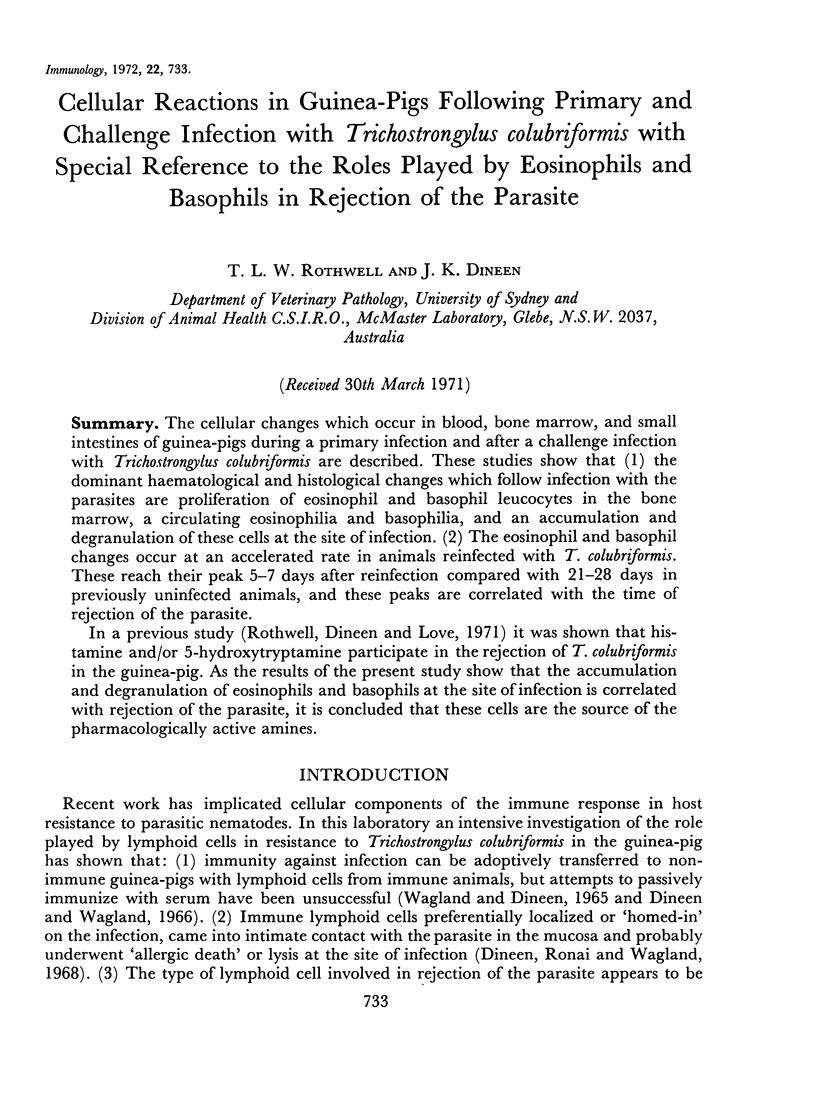
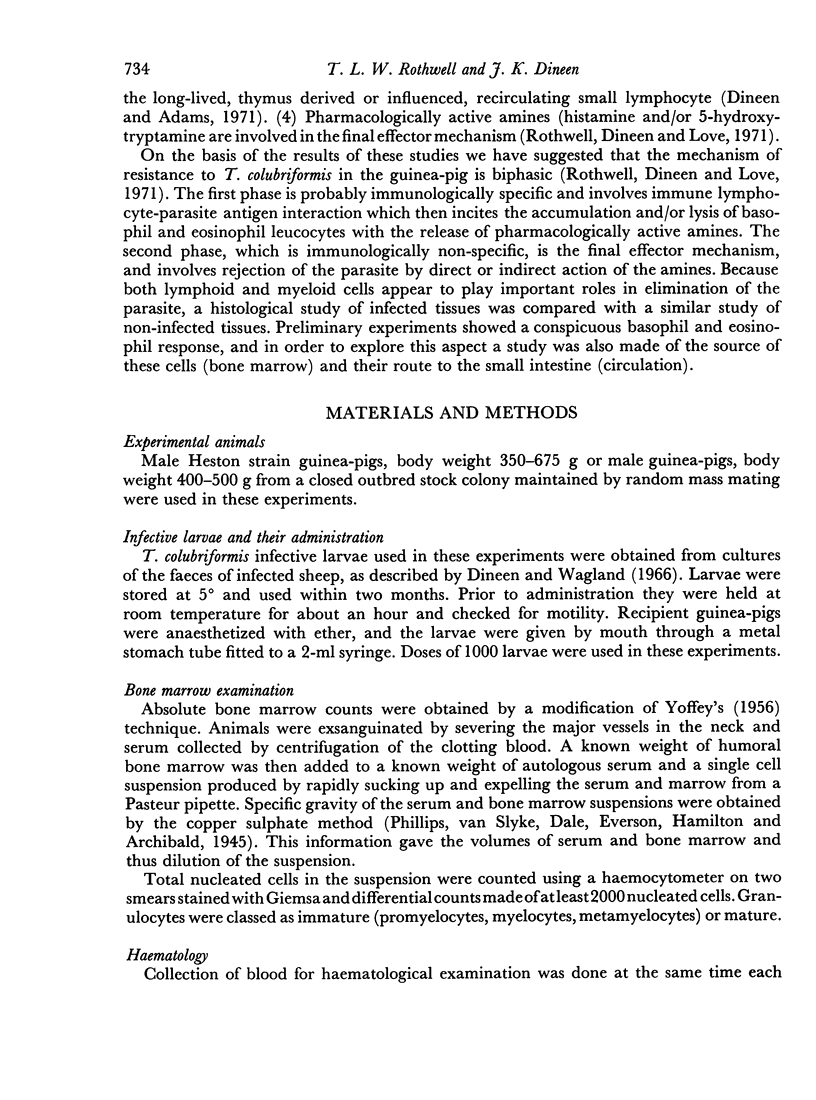
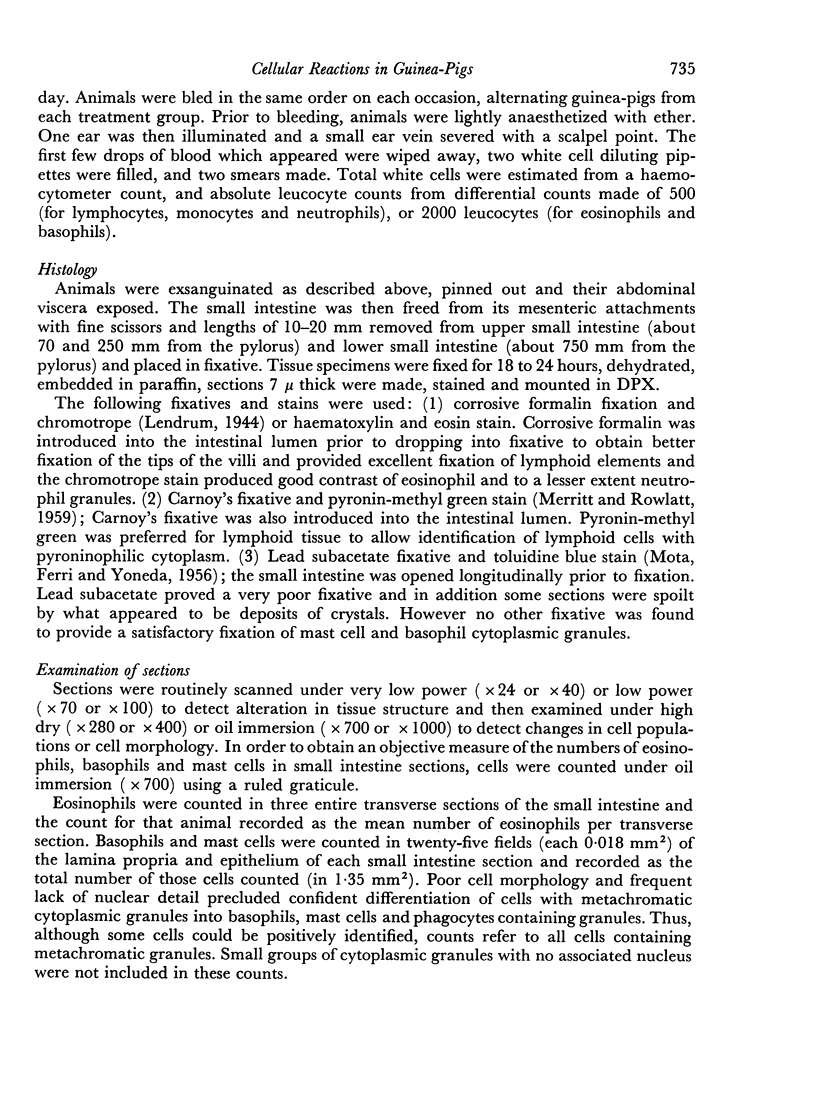
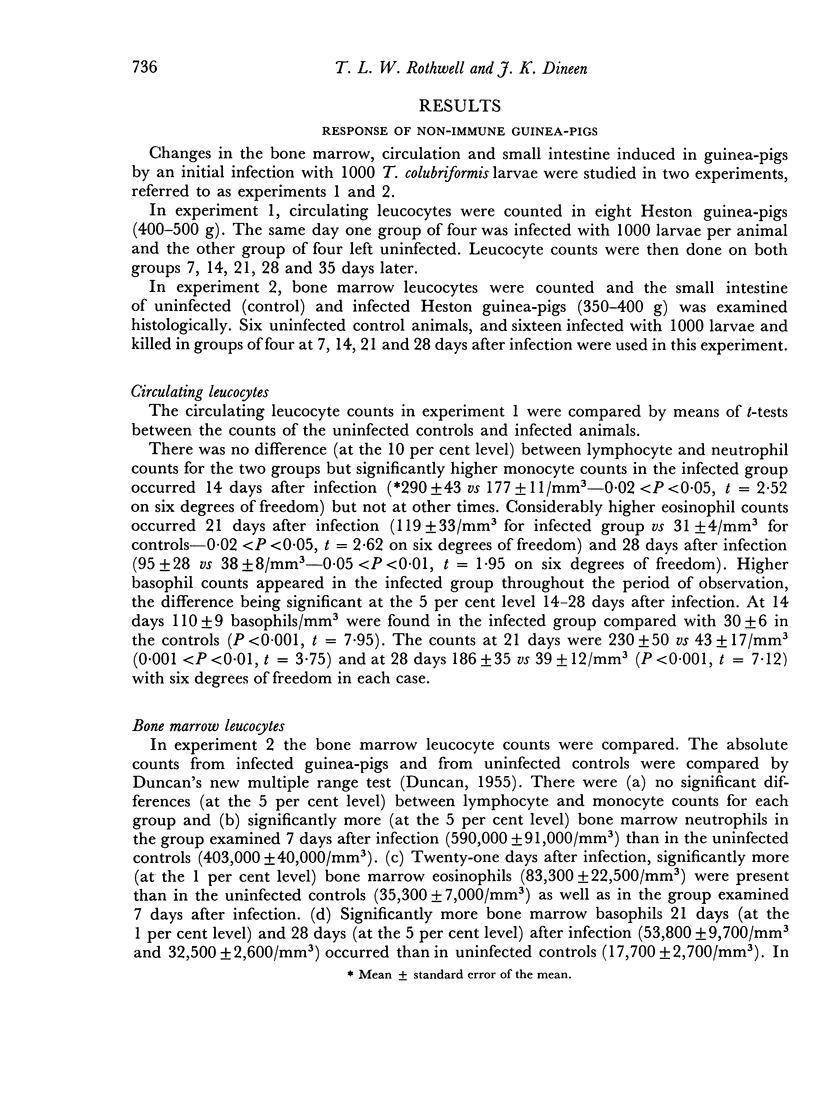
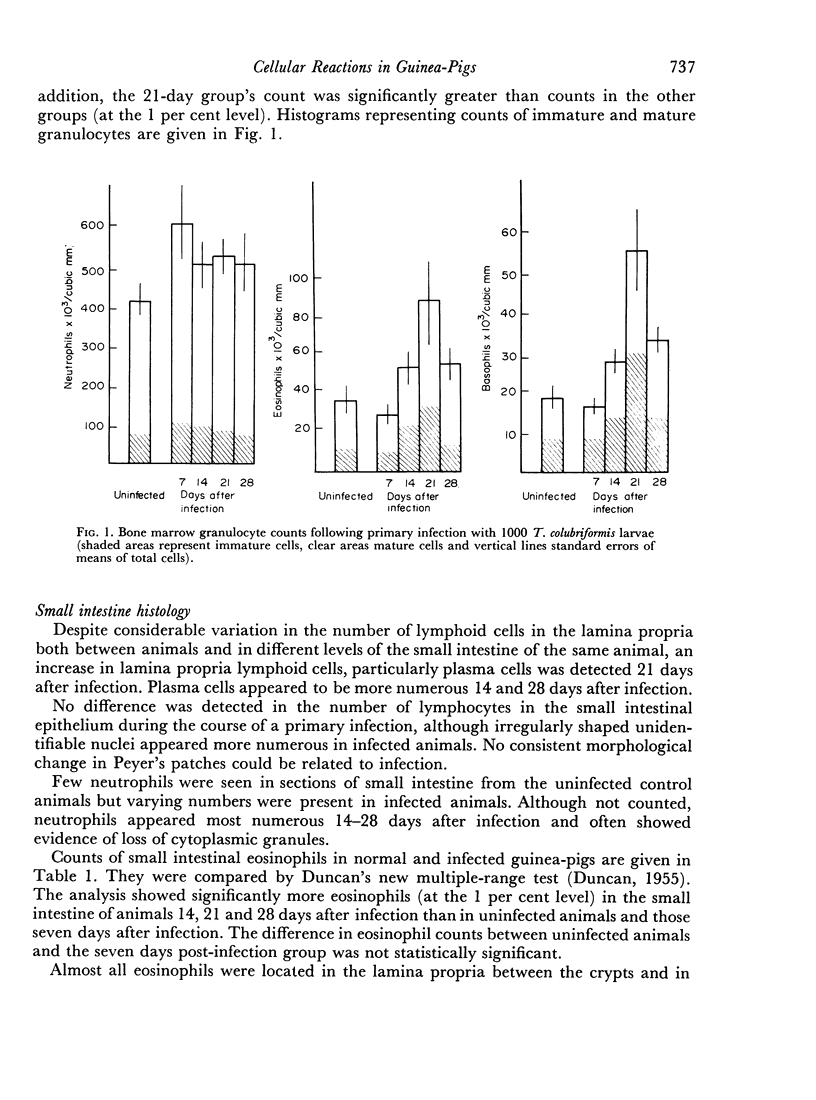
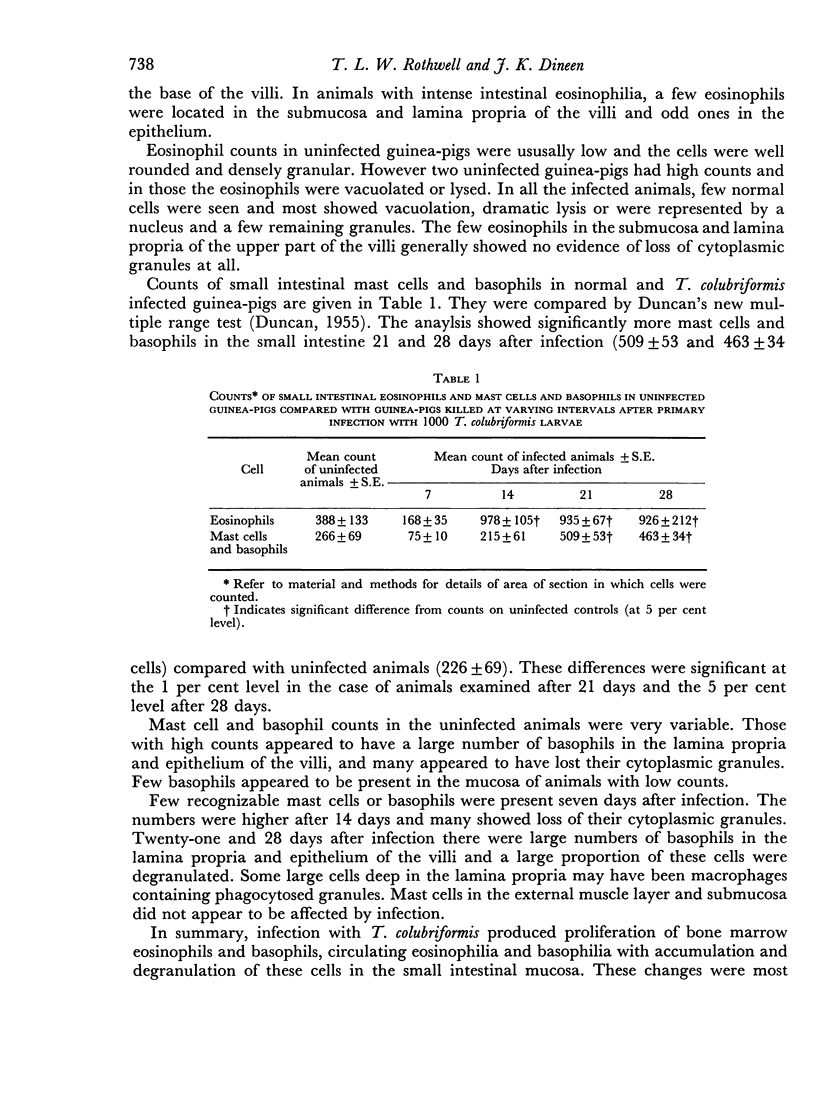
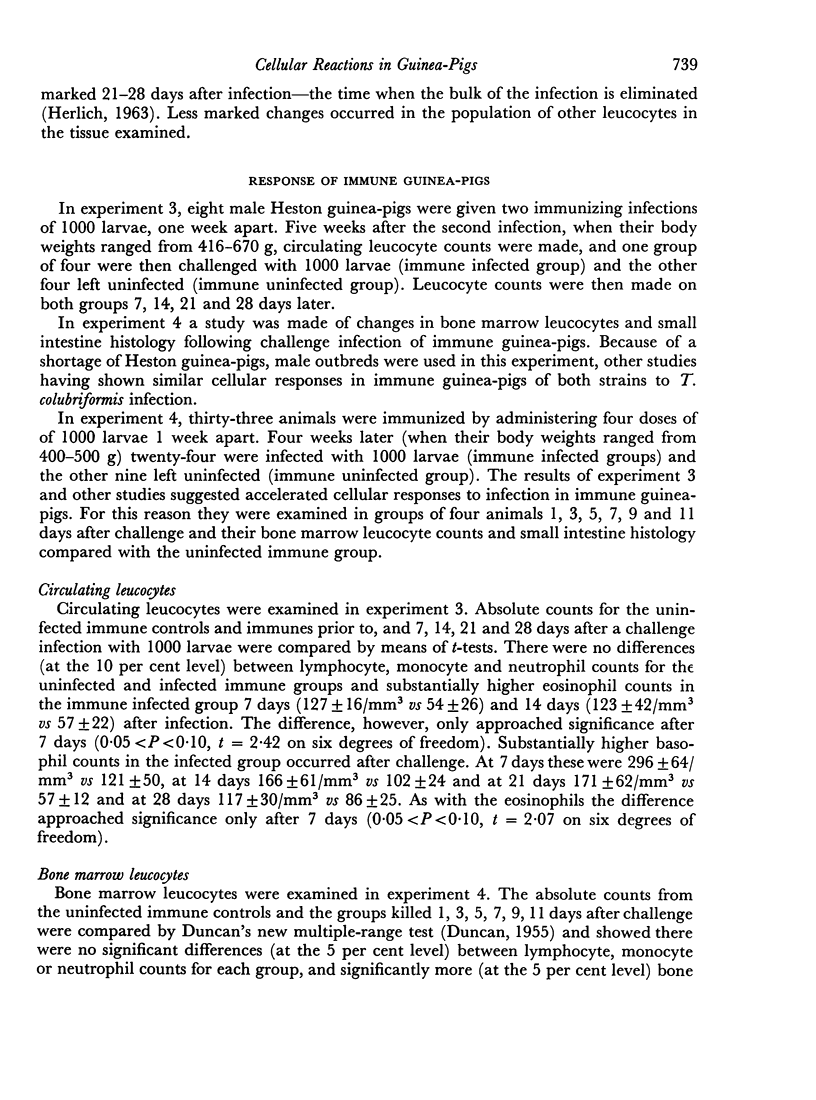
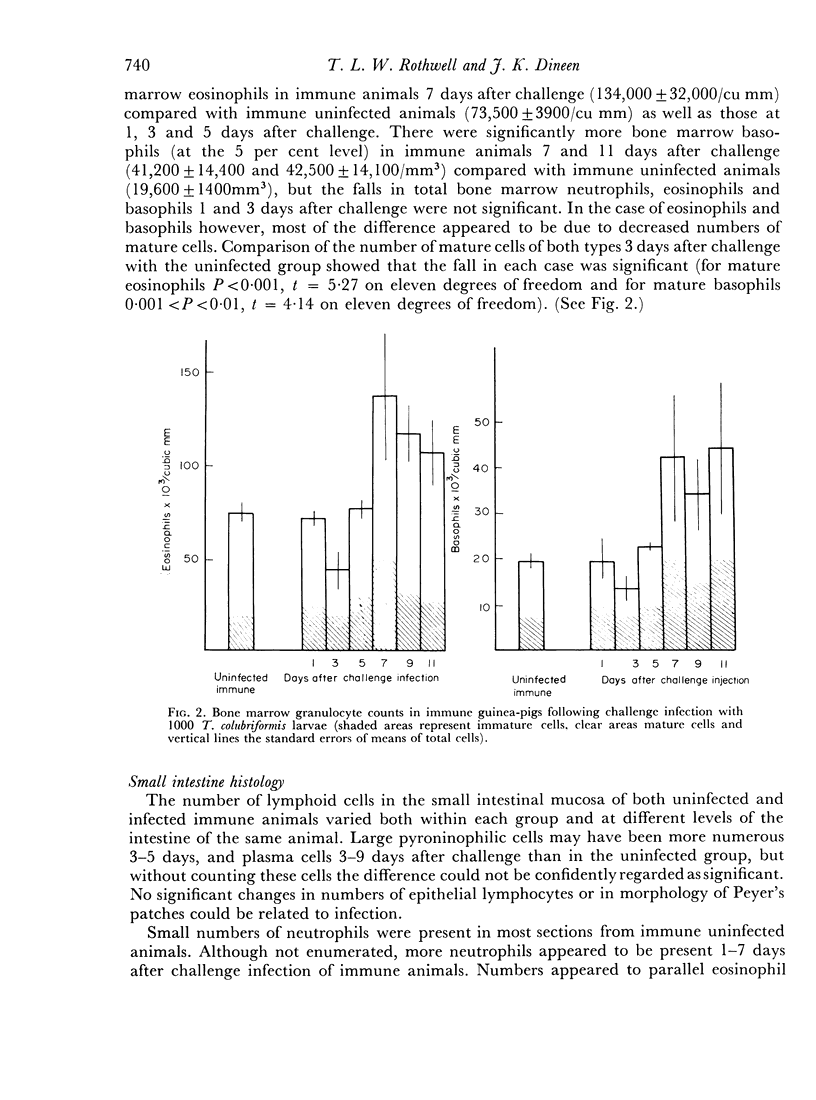
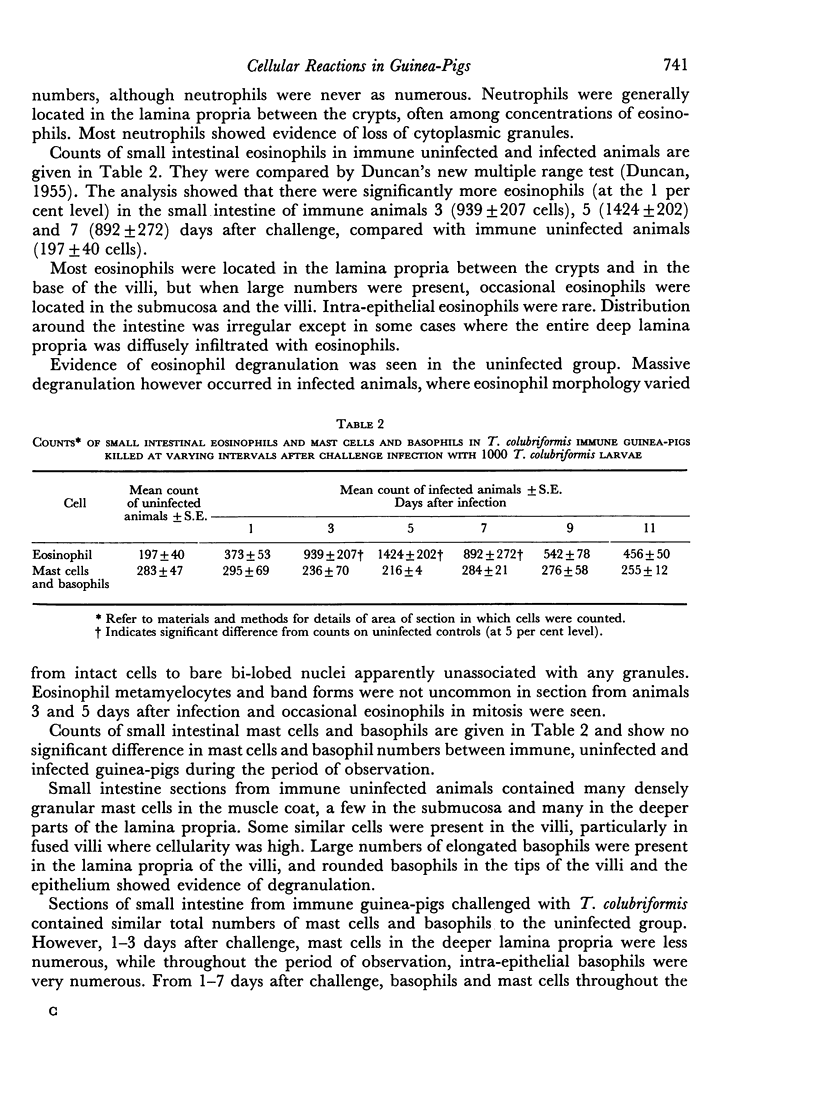

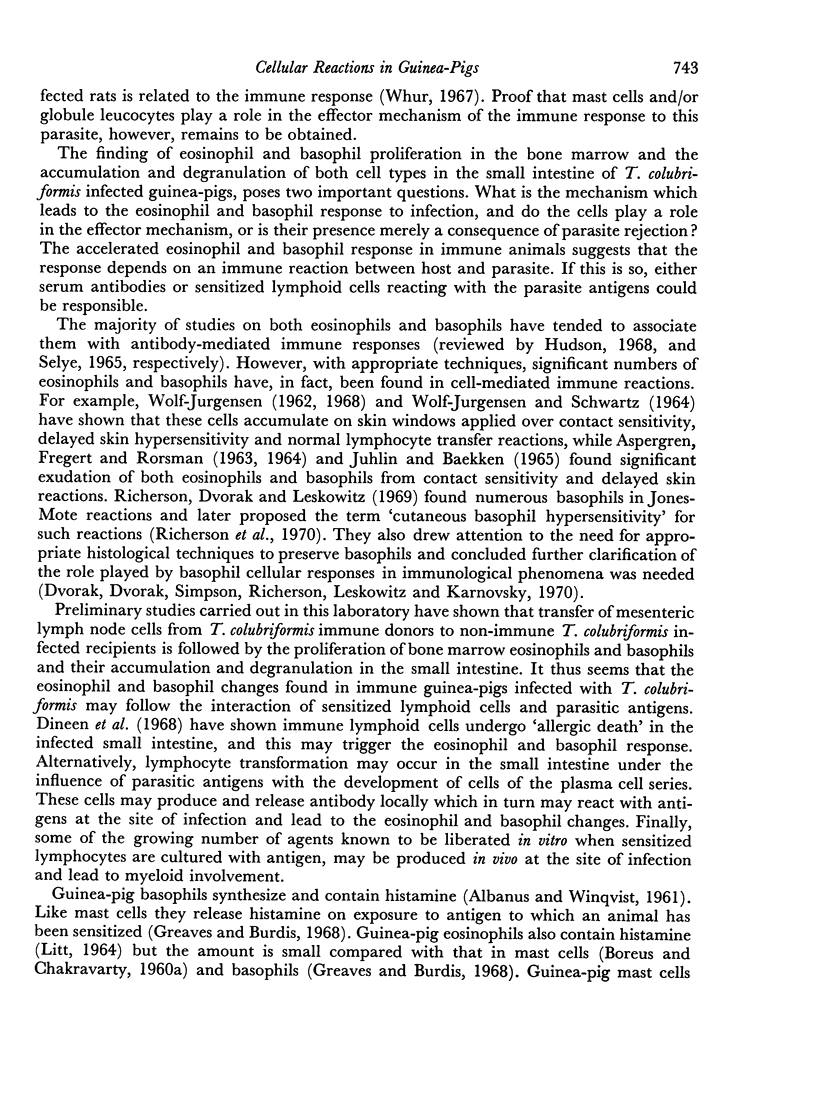
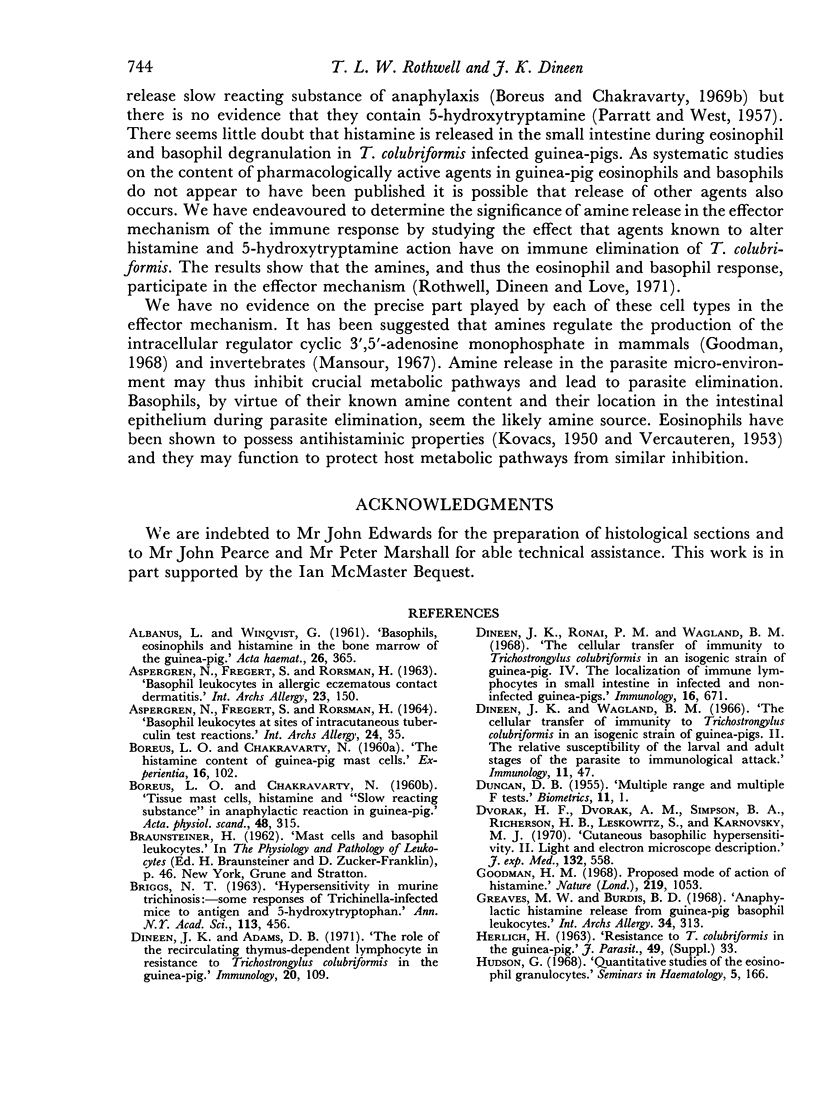
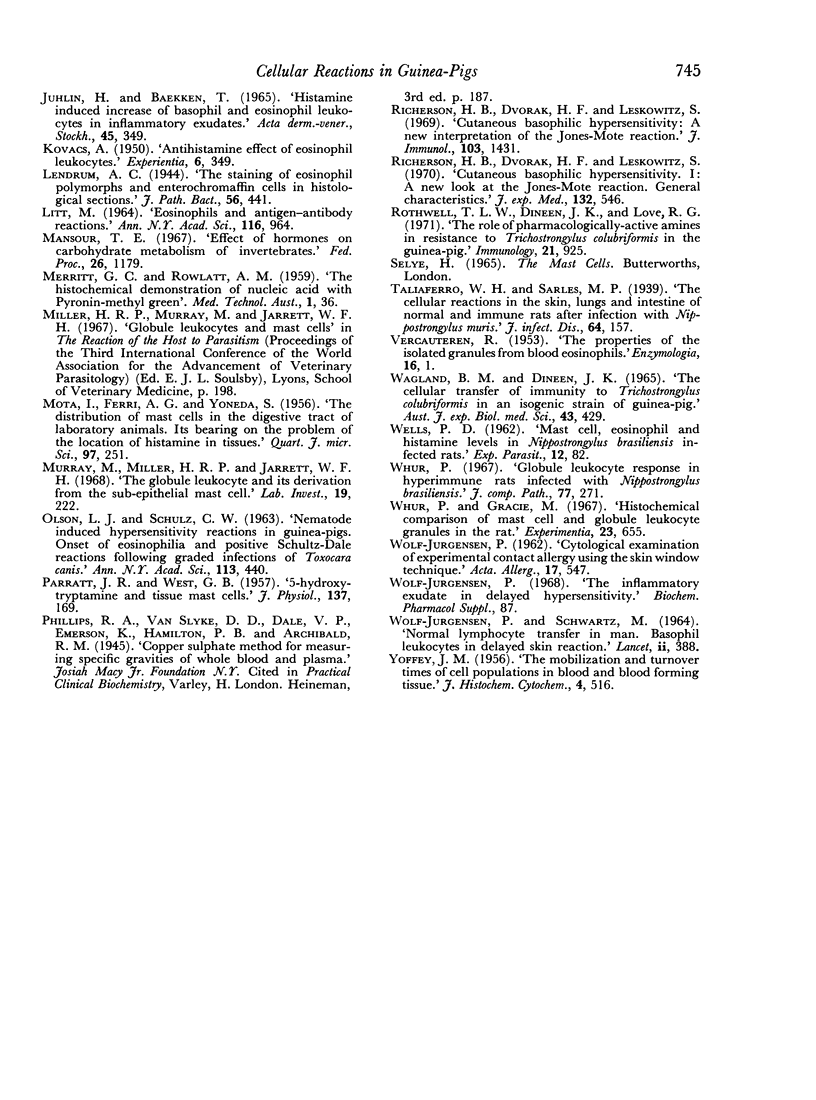
Selected References
These references are in PubMed. This may not be the complete list of references from this article.
- AGLAND B. M., DINEEN J. K. THE CELLULAR TRANSFER OF IMMUNITY TO TRICHOSTRONGYLUS COLUBRIFORMIS IN AN ISOGENIC STRAIN OF GUINES-PIG. Aust J Exp Biol Med Sci. 1965 Jul;43:429–438. doi: 10.1038/icb.1965.77. [DOI] [PubMed] [Google Scholar]
- ASPEGREN N., FREGERT S., RORSMAN H. BASOPHIL LEUKOCYTES IN ALLERGIC ECZEMATOUS CONTACT DERMATITIS. Int Arch Allergy Appl Immunol. 1963;23:150–156. doi: 10.1159/000229414. [DOI] [PubMed] [Google Scholar]
- BOREUS L. O., CHAKRAVARTY N. Tissue mast cells, histamine and 'slow reacting substance' in anaphylactic reaction in guinea pig. Acta Physiol Scand. 1960 Apr 25;48:315–322. doi: 10.1111/j.1748-1716.1960.tb01865.x. [DOI] [PubMed] [Google Scholar]
- BRIGGS N. T. HYPERSENSITIVITY IN MURINE TRICHINOSIS: SOME RESPONSES OF TRICHINELLA-INFECTED MICE TO ANTIGEN AND 5-HYDROXYTRYPTOPHAN. Ann N Y Acad Sci. 1963 Dec 30;113:456–466. doi: 10.1111/j.1749-6632.1963.tb40682.x. [DOI] [PubMed] [Google Scholar]
- Dineen J. K., Adams D. B. The role of the recirculating thymus-dependent lymphocyte in resistance to Trichostrongylus colubriformis in the guinea-pig. Immunology. 1971 Jan;20(1):109–113. [PMC free article] [PubMed] [Google Scholar]
- Dineen J. K., Ronai P. M., Wagland B. M. The cellular transfer of immunity to Trichostrongylus colubriformis in an isogenic strain of guinea-pig. IV. The localization of immune lymphocytes in small intestine in infected and non-infected guinea-pigs. Immunology. 1968 Nov;15(5):671–679. [PMC free article] [PubMed] [Google Scholar]
- Dineen J. K., Wagland B. M. The cellular transfer of immunity to Trichostrongylus colubriformis in an isogenic strain of guinea-pig. II. The relative susceptibility of the larval and adult stages of the parasite to immunological attack. Immunology. 1966 Jul;11(1):47–57. [PMC free article] [PubMed] [Google Scholar]
- Dvorak H. F., Dvorak A. M., Simpson B. A., Richerson H. B., Leskowitz S., Karnovsky M. J. Cutaneous basophil hypersensitivity. II. A light and electron microscopic description. J Exp Med. 1970 Sep 1;132(3):558–582. doi: 10.1084/jem.132.3.558. [DOI] [PMC free article] [PubMed] [Google Scholar]
- Goodman H. M. Proposed mode of action of histamine. Nature. 1968 Sep 7;219(5158):1053–1053. doi: 10.1038/2191053a0. [DOI] [PubMed] [Google Scholar]
- Greaves M. W., Burdis B. D. Anaphylactic histamine release from guinea pig basophil leucocytes; basophil leucocyte anaphylaxis. Int Arch Allergy Appl Immunol. 1968;34(4):313–323. doi: 10.1159/000230125. [DOI] [PubMed] [Google Scholar]
- Hudson G. Quantitative study of the eosinophil granulocytes. Semin Hematol. 1968 Apr;5(2):166–186. [PubMed] [Google Scholar]
- Juhlin L., Baekken T. Histamine induced increase of basophil and eosinophil leukocytes in inflammatory exudates. Acta Derm Venereol. 1965;45(5):349–354. [PubMed] [Google Scholar]
- KOVACS A. Antihistaminic effect of eosinophil leukocytes. Experientia. 1950;6(9):349–350. doi: 10.1007/BF02152872. [DOI] [PubMed] [Google Scholar]
- LITT M. EOSINOPHILS AND ANTIGEN-ANTIBODY REACTIONS. Ann N Y Acad Sci. 1964 Aug 27;116:964–985. doi: 10.1111/j.1749-6632.1964.tb52562.x. [DOI] [PubMed] [Google Scholar]
- Mansour T. E. Effect of hormones on carbohydrate metabolism of invertebrates. Fed Proc. 1967 Jul-Aug;26(4):1179–1185. [PubMed] [Google Scholar]
- OLSON L. J., SCHULZ C. W. NEMATODE INDUCED HYPERSENISTIVITY REACTIONS IN GUINEA PIGS: ONSET OF EOSINOPHILIA AND POSITIVE SCHULTZ-DALE REACTIONS FOLLOWING GRADED INFECTIONS WITH TOXOCARA CANIS. Ann N Y Acad Sci. 1963 Dec 30;113:440–455. doi: 10.1111/j.1749-6632.1963.tb40681.x. [DOI] [PubMed] [Google Scholar]
- PARRATT J. R., WEST G. B. 5-Hydroxytryptamine and tissue mast cells. J Physiol. 1957 Jul 11;137(2):169–178. doi: 10.1113/jphysiol.1957.sp005804. [DOI] [PMC free article] [PubMed] [Google Scholar]
- Richerson H. B., Dvorak H. F., Leskowitz S. Cutaneous basophil hypersensitivity. I. A new look at the Jones-Mote reaction, general characteristics. J Exp Med. 1970 Sep 1;132(3):546–557. doi: 10.1084/jem.132.3.546. [DOI] [PMC free article] [PubMed] [Google Scholar]
- Richerson H. B., Dvorak H. F., Leskowitz S. Cutaneous basophilic hypersensitivity: a new interpretation of the Jones-Mote reaction. J Immunol. 1969 Dec;103(6):1431–1434. [PubMed] [Google Scholar]
- Rothwell T. L., Dineen J. K., Love R. J. The role of pharmacologically-active amines in resistance to Trichostrongylus colubriformis in the guinea-pig. Immunology. 1971 Dec;21(6):925–938. [PMC free article] [PubMed] [Google Scholar]
- VERCAUTEREN R. The properties of the isolated granules from blood eosinophiles. Enzymologia. 1953 Apr 15;16(1):1–13. [PubMed] [Google Scholar]
- WELLS P. D. Mast cell, eosinophil and histamine levels in Nippostrongylus brasiliensis infected rats. Exp Parasitol. 1962 Apr;12:82–101. doi: 10.1016/s0014-4894(62)80002-2. [DOI] [PubMed] [Google Scholar]
- WOLF-JUERGENSEN P., SCHWARTZ M. NORMAL-LYMPHOCYTE TRANSFER IN MAN. BASOPHIL LEUCOCYTES IN DELAYED SKIN REACTION. Lancet. 1964 Aug 22;2(7356):388–390. doi: 10.1016/s0140-6736(64)90394-0. [DOI] [PubMed] [Google Scholar]
- WOLF-JURGENSEN P. Cytological examination of experimental contact allergy using the skin window technique. Acta Allergol. 1962;17:547–557. doi: 10.1111/j.1398-9995.1962.tb03124.x. [DOI] [PubMed] [Google Scholar]
- Whur P. Globule leucocyte response in hyperimmune rats infected with Nippostrongylus brasiliensis. J Comp Pathol. 1967 Jul;77(3):271–277. doi: 10.1016/0021-9975(67)90036-9. [DOI] [PubMed] [Google Scholar]
- Whur P., Gracie M. Histochemical comparison of mast cell and globule leucocyte granules in the rat. Experientia. 1967 Aug 15;23(8):655–657. doi: 10.1007/BF02144183. [DOI] [PubMed] [Google Scholar]
- YOFFEY J. M. The mobilization and turnover times of cell populations in blood and blood-forming tissue. J Histochem Cytochem. 1956 Nov;4(6):516–530. doi: 10.1177/4.6.516. [DOI] [PubMed] [Google Scholar]


